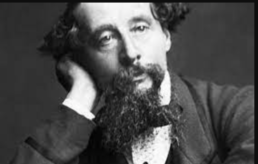These life stories may contain descriptions of childhood trauma and abuse, as well as images, voices and names of people now deceased. If you need help, you can find contact details for some relevant support services on our support page.
Venerated English writer, Charles Dickens (1812-1870), was in foster care during his childhood.
Charles John Huffam Dickens was born in Portsmouth, Hampshire. His parents, John and Elizabeth Dickens, moved frequently during his childhood, sometimes to benefit John’s career and sometimes because they needed to downsize during times of mounting debt.
Charles appears to have had a happy childhood until he was ten and his father suspended his education. The reason seems to be insufficient funds to provide schooling for both Charles and his older sister, Fanny, who in 1823 left home to become a boarder at the Royal Academy of Music.
Young Charles filled in his time by running errands for the family, reading, and exploring London. In 1824, shortly before his twelfth birthday, Charles began work in a blacking factory.
For six or seven shillings a week the boy would work a ten-hour day six days week, with an hour allowed for a mid-day meal and a half-hour for tea (Slater p. 20)
Before he had a chance to get used to his job, John Dickens was arrested and imprisoned. John was joined at Marshalsea prison by his wife and three youngest children, while Charles moved in with a family friend, Mrs Roylance.
On Sunday [Charles] would call for Fanny at the Music Academy and they would go together to the Marshalsea [Prison] which would mean a twelve-mile walk in total (Slater p. 22)
As Michael Slater says, the Sunday walk was in addition to the six long days of work Charles was already putting in.
The result was that the figures of inadequate, or downright culpable, parents and hapless, innocent child-victims were deeply imprinted upon his imagination at this time and later became central to his fictional world (Slater p. 22).
Later Charles moved in with another family, remembered as the Garland family in his novel, The Old Curiosity Shop, which was serialised 1840 to 1841. Because he was now closer to the prison he spent evenings with his family and often had breakfast with them too.
When John Dickens was released from prison, he and his family – minus Charles – moved in with their friend, Mrs Roylance, which meant that “Charles’ walks…once again became even longer treks” (Dickens Website). At the end of 1824, the family moved into an impoverished neighbourhood and Charles finally went back to school, at least for a couple of years.
In May 1827 he began work as a junior clerk for a local solicitor. Two years later he had learned shorthand and become a court stenographer, and followed this by becoming a “a shorthand reporter with the Mirror of Parliament. The Publication gave accounts of the activity in the House of Commons and the House of Lords” (Dickens Website).
A dinner at Poplar Walk was Dicken’s first literary publication. He followed this with The Pickwick Papers, serialised between 1836 and 1837 and Oliver Twist between 1837 and 1839.
Charles Dickens went on to write thirteen more novels as well as many novellas, short stories and essays. He is widely regarded as the greatest novelist of the Victorian era.
References:
Slater, Michael. Charles Dickens. New Haven: Yale University Press, 2009.
Charles Dickens Info. https://www.charlesdickensinfo.com/
Image available here.
